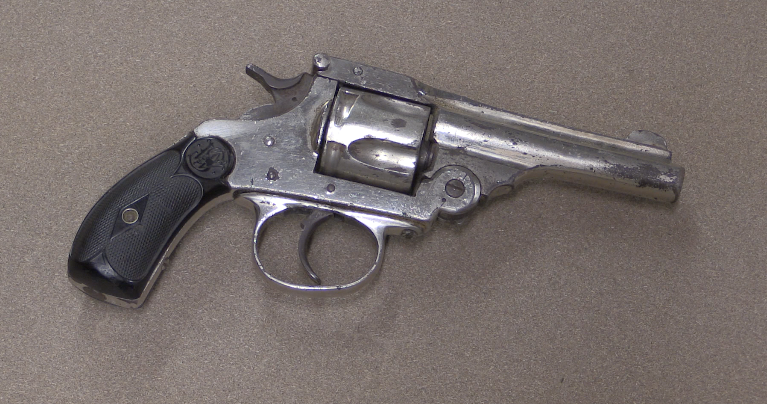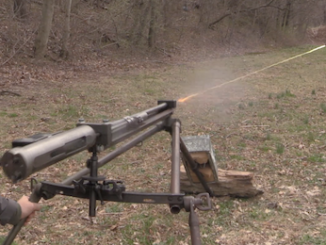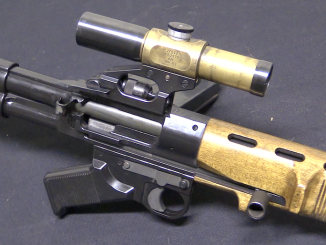The DeserTech MDR (“Micro Dynamic Rifle”) has been in the works for several years now, after being initially announced at SHOT Show in 2014, if I recall correctly. While it was probably prematurely unveiled, the rifle as it stands today looks to be remarkably well designed. It is one thing to design a concept that sounds attractive (fully ambidextrous bullpup rifle convertible between 7.62x51mm and 5.56x45mm), but it is a whole other thing to actually develop a mechanical design that actually works. And it is yet more notable to make that system elegantly simple and to actually transition from handmade prototypes to successful production line manufacture. DesertTech appears to have cleared all those hurdles…
At the heart of the rifle is a rotating bolt locking system and a short stroke gas system. These are both very well understood systems – DesertTech has chosen to use proven ideas here instead of getting “innovative”. The most interesting mechanical element is undoubtedly the ejection system, which can be swapped to eject from either side of the rifle but can actually be used from either shoulder regardless because it ejects cases directly forward. The system uses a pair of arms that push an empty case (or live round) laterally off the side of the bolt face and into a holding clip. A lug on the side of the bolt engages those arms on its rearward stroke, and a matching lug on the opposite side pushes the case forward and out of the rifle on the bolt’s forward stroke. While this system sounds complex, the parts appear to my eye to have gone through a lot of testing and revision, as they look pretty simple and sturdy – a refined implementation of an unorthodox idea.
The controls are all ambidextrous, with non-reciprocating bolt handles, safety selector, and magazine release on both sides. A secondary magazine release is located on the front of the magazine well to allow a positive magazine removal, and this catch is stiff enough to not have problems with accidental release like some other bullpup designs. The weakest point of the rifle as I see it is the trigger, with is creepy and heavier than I would have expected. The trigger group is completely modular, however, and I would expect to see aftermarket replacement triggers appear on the secondary market before too long.
The barrel can be removed easily with a hex wrench, and DeserTech is producing a 5.56mm conversion kit. This will involve replacing the bolt, barrel, and ejection panel and installing a magazine well insert for the smaller magazine (the 5.56mm version will use AR pattern standard mags). The upper and lower receiver assemblies are completely interchangeable between calibers. For those wishing to use a suppressor, the gas system is adjustable, with 3 positions including one for suppressed use.
The rifle ships with a micro red dot optic mounted in lieu of iron sights. It is mounted to a single unit section of Picatinny rail integral to the gas block, meaning that it will retain zero when the barrel is removed. For those preferring other sights, the top of the receiver has a length of rail for attaching whatever you like. The handguard also has a top rail, but I would not consider it to be solidly fixed enough to retain zero on an optic. The handguard also has side and bottom MLok slots for bipods and other accessories. The handguard is not connected to the barrel, so bipods on it are effectively free floated.
I am excited to see how the rifle handles on the range! After filming this, Karl and I took the MDR out to the range for some first shooting impressions. Check out that video on InRangeTV here:
https://youtu.be/DabLcqavXJ0




I can see a “electric” trigger on this gun. With an adjustable trigger pull, and a small electric magnet on the hammer, this would be somewhat lighter, and easier to maintain and shoot.
While using electric transmission is option, it would need voltage source to work.
However, I think one solution from past might be used there: Constantinesco
Colley gear, see page 3 of this pdf: http://www.quarryhs.co.uk/Synchro.pdf
it is hydrosonic signal transmitter. It might even allow ability to change trigger placement depending on user preferences.
Good show Ian, I like this rifle quite a bit.
But, before we start, let’s keep on mind – this is a civie rifle, it most likely won’t become a military issue (with police being exception, maybe). If there is a negative (in my eyes) it is bunch of exposed fasteners, military rifle cannot look that way. No tools, remember? Overall, bit sissy, but so what – it is for civilians and they like it that way.
This gives run for money to George Kelgren’s rifles – but the race is not conclusive by any means. George has some unique features on his which no one duplicated so far. Speaking of money, I believe that Keltech guns are priced quite reasonably, in relative terms.
Speaking of exposed fasteners; BT rifles and carbines have them too and co-incidentally they do not sell that well either. But fasteners on BT should not be blamed for that – there are probably other reasons including cost.
Okay I can imagine police with this. Perhaps they should also remember that this weapon comes with a great deal of responsibility and public visibility if misused. At least it’s more difficult to wrench away a bull-pup than a pistol held at arm’s length, let alone pull a fancy “field-strip out of your hands” trick.
“this is a civie rifle, it most likely won’t become a military issue”
Thus, it (configured to fire 5,56×45 cartridge) be compared to Bushmaster M17s
https://modernfirearms.net/en/assault-rifles/u-s-a-assault-rifles/bushmaster-m17s-eng/
though that latter was supposed to be military initially and later turned into civilian due to lack of demand for first type of application.
What I meant is U.S. military. They are not keen on bullpup at all.
For good reasons. We actually have people who know how to fight with rifles, as opposed to carrying them around like so many stage props.
You want a illustrated reason why so many US military members like myself are dubious about the merits of a bullpup design, look no further than the various and sundry videos the British Army puts up covering their CQB training operations. You’ll see dozens of instances where the trainees are stopping, taking their rifles off their shoulders, losing situational awareness, looking down at their weapons, and only then being able to perform a reload drill. In front of instructors, who not only don’t correct that suicidal technique, but encourage it, because that’s what the damn weapons require.
Bullpups are great ideas, administratively and on paper. To fight with? Not so much…
Of course, I beg to differ re Bullpups and have had to field some absolute mindnumbingly bizarre questions from other nations soldiers in the past such as “how often do you grab the magazine instead of the pistol grip”
The end of the day, if you’re trained up to a high standard, it doesn’t matter what weapon you’re issued, you’ll handle it like a champ. But what you’re used too also clouds your perception of other platforms, which is why Americans can’t get it out of their heads that anything other than an AR or conventional layout is the bee’s knees.
Oh, and using the British SA80 used by recruits with a high probability of zero prior weapons handling experience as a example… thats just not fair.
“Overall, bit sissy, but so what – it is for civilians and they like it that way.”
For military bull-pup rifle with similar casing ejections see
https://en.wikipedia.org/wiki/A-91
xor
https://en.wikipedia.org/wiki/ADS_amphibious_rifle
notice that grenade-launcher, beyond being grenade-launcher, also acts like counter-weight, causing point of center-of-mass to be more near muzzle.
I know about ADS – they are superb. But, that’s Russian way to skate.
On subject of ejection and relative to military requirements: actually, in this case there is a value in this system for being, so to say, more “discrete”. Therefor yes, it may have military application.
If I gave just an opposite case to illustrate its prove, it would be vz.58, I should be (at least in memory) familiar with. That particular rifle was betraying itself by steady stream of casing spewing out like a fountain. Here I am, here…here you shoot! 🙂
Hilariously, people tend to ignore the more obvious give-away of spraying assault rifle fire down range: the spray attracts heavier weapons like mortars, machine guns, or even armored vehicles (including tanks). And don’t think about using your assault rifle to spray a field gun battery, not even if you’re about 50 meters away from it and behind “bulletproof” cover. You’re going to eat solid shot, high explosives, or even a shrapnel sandwich if you try it. I could be wrong.
It is the modern version of all the concerns about the “ping” of the Garand clip ejecting. I’m pretty sure that nobody ever died solely because of that issue, and while some may have been killed because they flubbed their reload, that “ping” wasn’t what caused their deaths.
At range, those “fountains of brass” are essentially invisible. Not to mention, if you are in a position to observe them, you have other worries… Ones that should serve to distract.
Add in the less-than-noticeable nature of Warsaw Pact lacquered steel cases? I think this is an imaginary problem. For the US? Maybe not, with our predilection for shiny yellow brass.
I was talking about the noise and muzzle flash of gunfire attracting attention, not the glint from the brass doing it! The aftermath of a fool spraying assault rifle fire upon an enemy field gun at night can be summed up with this the following morning: “Hey, look, it’s Napoleon Blown-apart, ha, ha, ha!”
I meant to be agreeing with you…
Well, you tell me what you would look for in situation like this:
you are in tall grass at the edge of forest and suddenly someone fired short burst at you. You know general direction, but cannot tell for sure. You peer carefully for signs of motion, flash of anything telling. Now the guy across fires again and you see casings popping high in the air. You load your M203 and send him a greetings. Done.
Yeah… No. I’ve never ever been able to make out enemy brass flying during training, and I know of no combat veterans who did so under fire and reported same. Even against some guys who had vz. 58s…
I think it’s an entirely theoretical issue, and one that can be easily overcome by the same sort of measures taken to avoid raising dust, which is actually far more noticeable than one might think, even under conditions that aren’t desert-dry.
As a CETME C user a downward ejection would be wonderful. With out a deflector casings fly for many yards to the right. Impossible to ignore. I always wondered how well that worked in combat. Good thing the Spanish army not in a lot of conflicts!
This may be the first bullpup I have seen that I did not take an instant dislike to… Sole issue I don’t like is the bolt catch release location. I want that where my firing hand can control it, period.
Looks good but what about accomidating body armor? I don’t see any way to adjust length of pull.
Here is Keltec RDB
https://www.youtube.com/watch?v=BASgtPpYfF0
Ian
Re: video of test firing
What would happen if the forward ejection plate assembly was left off of the rifle? Might that solve many of the ejection problems?
Perhaps, but extraction seems a bit less than optimal. Ejection happens after extraction.
After viewing the test firing video this rifle will easily slide into the forgotten weapon category.
Re: FAMAS best bullpup?
The best bullpup of all still seems like the Singapore SAR-21.
So, do ANY bullpups have decent triggers? I was surprised that the trigger only came up so near the end. I suppose the order of disassembly sort of dictates that, but I was remembering previous examples so I was waiting to hear how Desertech had found a solution…
“decent triggers”
There exist so-called TRIGGERTAMERTM: http://www.triggertamer.com/ which is supposed to improve Steyr AUG trigger, how well it works I do not known. Anyone has any experience with that solution?
This is fascinating piece of engineering, full of of gizmos & doo-dads. Not really suitable to be a military rifle, though. If one has to remove the barrel & handguard to field-strip it, it is an unnecessarily complicated procedure. It’s also sad that despite Ian & Karl NOT blowing sand into it or dunking it mud, it still wouldn’t run properly.
I’ve voiced my dislike of bullpups here before as being little grenades waiting to blow your face off in the event of a catastrophic failure. That little port will not be able to prevent a full ‘kaboom’. There are enough bolt actions with 2 ports that vent gas into open air that have failed & blown the bolt to make me leery of this rifle.
$2500? Yeah, I know there are AR’s that cost that much, but I can buy a comfortable to shoot, perfectly reliable LR308, 5 magazines, a decent optic, 1000 rounds of 7.62 & replace some small parts and still have leftover change!
I know every company thinks they have ‘the next big thing’ & are going to sell a boatload of ’em, but unless there’s a drastic leap forward in firearms technology, any successful new rifle will be based in some way off the AR or AK pattern. I foresee the amount invested in this POS will eventually bankrupt Desert Tech.
When Ian said “…this isn’t a forgotten weapon…”, he forgot to say “yet”.
Hi Ian!
I’d like to mention that the ejection mechanism on this gun is not actually completely unheard of. Not sure how much experience you have with soviet/russian heavy machineguns, but during my service in the Finnish Defence forces I got some experience handling and firing the NSV .50 caliber AA gun. The NSV actually has a remarkably similar ejection system, where a lever on the right side of the receiver pushes the spent casing/extracted cartridge sideways to the right, and when the bolt goes forwards again it is ejected through a ‘tube’ or a ‘chute’, for lack of a correct term. The ejection chute is on the right side of the receiver. I can’t seem to find any pictures online that show the mechanism, but it is exactly the same principle, although on the MDR here they use a two-part scissor mechanism as you pointed out. On the NSV it’s a single lever. Maybe because of lack of space? The NSV receiver is certainly very spacious, but then it is a crew-served .50 cal. The NSV itself is a 1960’s design, but I believe it has it’s roots in the 1950’s soviet GPMG project that led to the PKM, so definitely not the first time this kind of system has been used. But very cool to see that this idea of ejection has been used elsewhere. Do you have any idea of other weapons that have used this kind of system for ejection, would like to know about them if you do.
Cheers from Finland, keep up the good work!
Hi Aku:
A little mistake,the lever push the spent case to right is locted on the left side.
I am curious to know the Russian’s forward ejection mechanism.Finally, I find the patent on Kord 12.7mm machine gun which shows its mechanism. It is quite simple just a lever with spring bias.
DT rechambers the MDR to fire M14 cartridges.
If there’s ever a MDR 2.0, I’m betting that it will do away with the forward ejection idea. Isn’t it kind of obvious to just use two scissor mechanisms? I would mount them on rails in the receiver and place them under spring tension. When you want to switch ejection, you would pull open one port cover/scissor mechanism until it latches into the receiver. Pulling open the near cover causes the opposite cover/scissor mechanism to close under spring tension and latch into the receiver.
I think this system would also address one of the deficiencies that I see in the MDR design: the lack of support that the bolt provides to the cartridge case. The rim of the case only seems to be supported by the “ledge” spanning the two lugs opposite the extractor so that the case can “slide” across the bolt face and into the ejection chute. Does the barrel extensions provide additional support?
Interestingly, the CMG-2 and CMG-3 used “external” ejectors like the MDR but provided support over almost the entire case rim. As Ian showed in his examination of those machine guns, the case slides across the bolt face and into an extractor groove that is only broken where it receives the cartridge through the feed tray. The beefy ejector lever, however, has enough momentum to pivot the case out of the extractor groove to eject it. This lead me to believe that the MDR should be able to get away with a single extractor at the 12:00 position, where it is currently located so that either the ejector at the 3:00 or 9:00 position can eject the case out of the opposite ejection port.